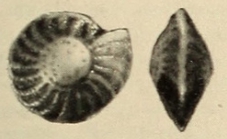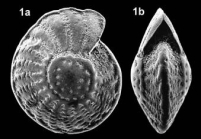WoRMS taxon details
Palaeoelphidium Consorti, Schlagintweit & Rashidi, 2018 †
1288816 (urn:lsid:marinespecies.org:taxname:1288816)
accepted
Genus
Elphidiella multiscissurata Smout, 1955 † accepted as Palaeoelphidium multiscissuratum (Smout, 1955) † (type by original designation)
marine, brackish, fresh, terrestrial
fossil only
neuter
Consorti, L.; Schlagintweit, F.; Rashidi, K. (2018). Palaeoelphidium gen. nov. (type species: Elphidiella multiscissurata Smout 1955): The oldest Elphidiellidae (benthic foraminifera) from Maastrichtian shallow-water carbonates of the Middle East. <em>Cretaceous Research.</em> 86: 163-169., available online at https://doi.org/10.1016/j.cretres.2018.02.011
page(s): p. 165 [details]
page(s): p. 165 [details]
Hayward, B.W.; Le Coze, F.; Vachard, D.; Gross, O. (2024). World Foraminifera Database. Palaeoelphidium Consorti, Schlagintweit & Rashidi, 2018 †. Accessed through: World Register of Marine Species at: https://www.marinespecies.org/aphia.php?p=taxdetails&id=1288816 on 2024-09-23
Date
action
by
![]() The webpage text is licensed under a Creative Commons Attribution 4.0 License
The webpage text is licensed under a Creative Commons Attribution 4.0 License
original description
Consorti, L.; Schlagintweit, F.; Rashidi, K. (2018). Palaeoelphidium gen. nov. (type species: Elphidiella multiscissurata Smout 1955): The oldest Elphidiellidae (benthic foraminifera) from Maastrichtian shallow-water carbonates of the Middle East. <em>Cretaceous Research.</em> 86: 163-169., available online at https://doi.org/10.1016/j.cretres.2018.02.011
page(s): p. 165 [details]
page(s): p. 165 [details]
From editor or global species database
Diagnosis Test symmetrical, lenticular and biumbonate. Chambers arranged in a single involute plani-spire. A wide canaliculate umbilical plug pierced by vertical canals occupies both sides of the shell. Chambers have an acute periphery without defined keel. Aperture interiomarginal composed by a row of ten intercameral foramina (Smout, 1955). Chamber sutures occupied by massive ponticuli (no canal bearing; sensu Hansen and Likke-Andersen, 1976). No retral processes are present. Alar prolongation provided by a folium at the adaxial end of chambers. An incomplete spiral interlocular space, called ‘groove’ by Smout (1955), arises between adaxial end of folia of the last ten chambers and the umbilical plug. An umbilical plate, which is composed by two symmetrical branches, separates folium and the main chamber lumen; this disposition is typical in planispiral genera (Hottinger et al., 2001). There are two spiral umbilical canals, one in each side of the shell, constrained between folium, umbilical plate and the adjacent coil. The spiral umbilical canals are tubular and continuous. An interconnected network of vertical, spiral and intraseptal interlocular canals composes the canal system. Dimorphism not observed. [details]


